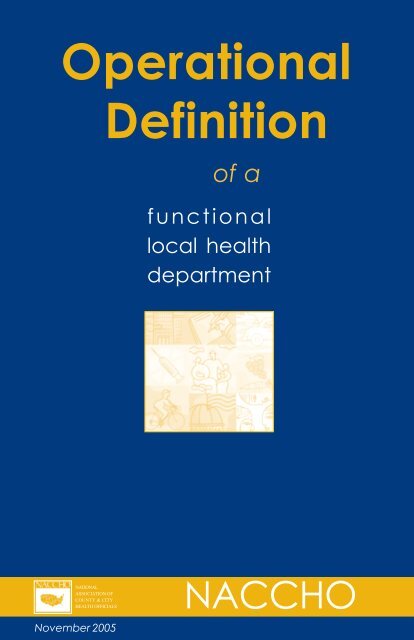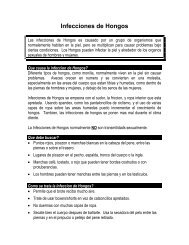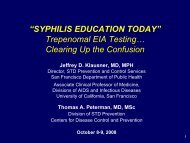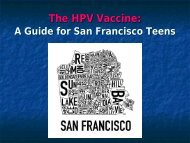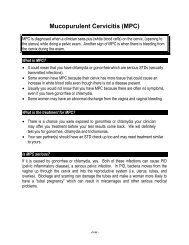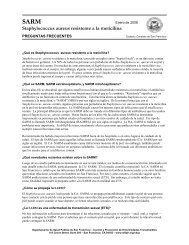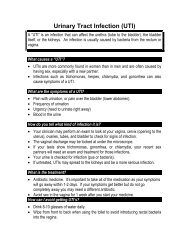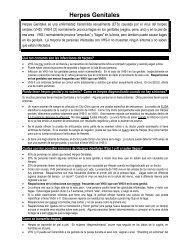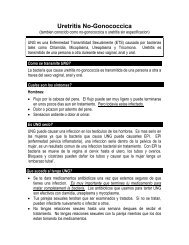Definition of a Functional Health Department, NACCHO, 2006
Definition of a Functional Health Department, NACCHO, 2006
Definition of a Functional Health Department, NACCHO, 2006
Create successful ePaper yourself
Turn your PDF publications into a flip-book with our unique Google optimized e-Paper software.
<strong>NACCHO</strong>• Addresses health disparities.• Serves as an essential resource forlocal governing bodies andpolicymakers on up-to-datepublic health laws and policies.• Provides science-based, timely,and culturally competent healthinformation and health alerts tothe media and to the community.• Provides its expertise to otherswho treat or address issues <strong>of</strong>public health significance.• Ensures compliance with publichealth laws and ordinances,using enforcement authoritywhen appropriate.• Employs well-trained staffmembers who have the necessaryresources to implement bestpractices and evidence-basedprograms and interventions.• Facilitates research efforts, whenapproached by researchers, thatbenefit the community.• Uses and contributes to theevidence base <strong>of</strong> public health.• Strategically plans its services andactivities, evaluates performanceand outcomes, and makesadjustments as needed tocontinually improve itseffectiveness, enhance thecommunity’s health status, andmeet the community’sexpectations.NOTES1For the purposes <strong>of</strong> this definition, alocal health department may be locallygoverned, part <strong>of</strong> a region or district, bean <strong>of</strong>fice or an administrative unit <strong>of</strong> thestate health department, or a hybrid <strong>of</strong>these.2See “Local <strong>Health</strong> <strong>Department</strong>Standards,” Pages 4 through 9, for furtherdescription <strong>of</strong> the functions captured inthis definition.Operational <strong>Definition</strong> <strong>of</strong> a <strong>Functional</strong> Local <strong>Health</strong> <strong>Department</strong> • November 20053
l o c a l h e a l t h d e p a r t m e n tstandardsAll local health departments(LHDs), 1 as governmentalentities, derive their authorityand responsibility from the state andlocal laws that govern them.Accordingly, all LHDs exist for thecommon good and are responsiblefor demonstrating strong leadershipin the promotion <strong>of</strong> physical,behavioral, environmental, social,and economic conditions thatimprove health and well-being;prevent illness, disease, injury, andpremature death; and eliminatehealth disparities. 2 However, in theabsence <strong>of</strong> specific, consistentstandards regarding how LHDs fulfillthis responsibility, the degree towhich the public’s health is protectedand improved varies widely fromcommunity to community.These standards describe theresponsibilities that every person,regardless <strong>of</strong> where they live, shouldreasonably expect their LHD to fulfill.They have been developed withinnationally recognized frameworks 3and with input from public healthpr<strong>of</strong>essionals and elected <strong>of</strong>ficials 4from across the country. Thestandards provide a framework bywhich LHDs are accountable to thestate health department, the publicthey serve, and the governing bodies(e.g., local boards <strong>of</strong> health, countycommissioners, and mayors) to whichthey report. In meeting the<strong>NACCHO</strong>4NATIONALASSOCIATION OFCOUNTY & CITYHEALTH OFFICIALSstandards, LHDs employ strategiesthat are evidence-based and informedby best practices, and they operateaccording to the highest level <strong>of</strong>pr<strong>of</strong>essionalism and ethics to inspirepublic confidence and trust.A number <strong>of</strong> factors contribute to thevariability <strong>of</strong> how LHDs operate;specifically capacity, authority,resources, and composition <strong>of</strong> thelocal public health system:•••The LHD may have the capacityto perform all <strong>of</strong> the functions onits own; it may call upon thestate to provide assistance forsome functions; it may developarrangements with otherorganizations in the communityor with neighboring LHDs toperform some functions; or it maycontrol the means by whichother entities perform somefunctions.Government agencies other thanthe LHD may have the authorityto perform services that affectpublic health.Resources for public health maybe housed in a different agency.• Each LHD jurisdiction is served byits own unique public healthsystem: public and private healthcare providers, businesses,community organizations,academic institutions, and mediaoutlets that all contribute to thepublic’s health.
<strong>NACCHO</strong>As a result <strong>of</strong> these differences, howLHDs meet the standards—whetherthey directly provide a service, brokerparticular capacities, or otherwiseensure that the necessary work isbeing done—will vary. Regardless <strong>of</strong>its specific capacity, authority, andresources, and regardless <strong>of</strong> theparticular local public health system,the LHD has a consistentresponsibility to intentionallycoordinate all public health activitiesand lead efforts to meet thestandards.The standards are a guide to thefundamental responsibilities <strong>of</strong> LHDs,allowing for varied structuralcharacteristics <strong>of</strong> LHDs (e.g.,governance, staffing patterns, size <strong>of</strong>the population served, etc.), andrecognizing that each LHD may haveother duties unique to meeting thepublic health needs <strong>of</strong> the communityit serves. Several states havedeveloped, or are in the process <strong>of</strong>developing, state-specific standardsfor LHDs, and the National Public<strong>Health</strong> Performance StandardsProgram (NPHPSP) includes standardsfor local public health systems.<strong>NACCHO</strong> analyses <strong>of</strong> several stateinitiatives and the NPHPSP haveshown a high level <strong>of</strong> consistencybetween these efforts and <strong>NACCHO</strong>’snationally developed standards.Currently, not all LHDs have thecapacity to meet the standards. Manyconcerns have been raised regardingthe costs <strong>of</strong> developing the capacity,and the implications for LHDs that donot meet the standards. It is difficultto anticipate costs, and it is equallyimportant to understand thatimprovements in capacity can bemade in the absence <strong>of</strong> newresources. <strong>NACCHO</strong> is committed tocollecting and sharing models <strong>of</strong>LHDs and LHD arrangements todemonstrate various means toenhance local governmental publichealth capacity. Furthermore,<strong>NACCHO</strong> is currently participating ina national dialogue on whether toestablish a voluntary nationalaccreditation system for state andlocal health departments, 5 and issupportive <strong>of</strong> such an effort. 6 Theresults <strong>of</strong> this dialogue may generateimplications for LHDs not meeting thestandards.<strong>NACCHO</strong> urges LHDs to embracethese standards both as a means <strong>of</strong>working with their state healthdepartments, communities, andgoverning bodies to develop a morerobust governmental public healthcapacity, and as a means <strong>of</strong> holdingthemselves uniformly accountable tothe public they serve.Operational <strong>Definition</strong> <strong>of</strong> a <strong>Functional</strong> Local <strong>Health</strong> <strong>Department</strong> • November 20055
l o c a l h e a l t h d e p a r t m e n tstandards1Monitor health status andunderstand health issues facingthe community.a. Obtain and maintain data thatprovide information on thecommunity’s health (e.g., providerimmunization rates; hospitaldischarge data; environmentalhealth hazard, risk, and exposuredata; community-specific data;number <strong>of</strong> uninsured; andindicators <strong>of</strong> health disparities suchas high levels <strong>of</strong> poverty, lack <strong>of</strong>affordable housing, limited or noaccess to transportation, etc.).b. Develop relationships with localproviders and others in thecommunity who have informationon reportable diseases and otherconditions <strong>of</strong> public health interestand facilitate informationexchange.c. Conduct or contribute expertise toperiodic community healthassessments.d. Integrate data with healthassessment and data collectionefforts conducted by others in thepublic health system.e. Analyze data to identify trends,health problems, environmentalhealth hazards, and social andeconomic conditions that adverselyaffect the public’s health.<strong>NACCHO</strong>6NATIONALASSOCIATION OFCOUNTY & CITYHEALTH OFFICIALS2Protect people from healthproblems and health hazards.a. Investigate health problems andenvironmental health hazards.b. Prevent, minimize, and containadverse health events andconditions resulting fromcommunicable diseases; food-,water-, and vector-borne outbreaks;chronic diseases; environmentalhazards; injuries; and healthdisparities.c. Coordinate with othergovernmental agencies thatinvestigate and respond to healthproblems, health disparities, orenvironmental health hazards.d. Lead public health emergencyplanning, exercises, and responseactivities in the community inaccordance with the NationalIncident Management System, andcoordinate with other local, state,and federal agencies.e. Fully participate in planning,exercises, and response activitiesfor other emergencies in thecommunity that have public healthimplications, within the context <strong>of</strong>state and regional plans and in amanner consistent with thecommunity’s best public healthinterest.f. Maintain access to laboratory andbiostatistical expertise and capacityto help monitor community healthstatus and diagnose andinvestigate public health problemsand hazards.g. Maintain policies and technologyrequired for urgentcommunications and electronicdata exchange.
<strong>NACCHO</strong>3Give people information theyneed to make healthy choices.a. Develop relationships with themedia to convey information <strong>of</strong>public health significance, correctmisinformation about publichealth issues, and serve as anessential resource.b. Exchange information and datawith individuals, communitygroups, other agencies, and thegeneral public about physical,behavioral, environmental, social,economic, and other issuesaffecting the public’s health.c. Provide targeted, culturallyappropriate information to helpindividuals understand whatdecisions they can make to behealthy.d. Provide health promotionprograms to address identifiedhealth problems.4Engage the community toidentify and solve healthproblems.a. Engage the local public healthsystem in an ongoing, strategic,community-driven, comprehensiveplanning process to identify,prioritize, and solve public healthproblems; establish public healthgoals; and evaluate success inmeeting the goals.b. Promote the community’sunderstanding <strong>of</strong>, and advocacyfor, policies and activities that willimprove the public’s health.c. Support, implement, and evaluatestrategies that address publichealth goals in partnership withpublic and private organizations.d. Develop partnerships to generateinterest in and support forimproved community health status,including new and emergingpublic health issues.e. Inform the community, governingbodies, and elected <strong>of</strong>ficials aboutgovernmental public healthservices that are being provided,improvements being made inthose services, and priority healthissues not yet being adequatelyaddressed.5Develop public health policiesand plans.a. Serve as a primary resource togoverning bodies andpolicymakers to establish andmaintain public health policies,practices, and capacity based oncurrent science and best practices.b. Advocate for policies that lessenhealth disparities and improvephysical, behavioral, environmental,social, and economic conditions inthe community that affect thepublic’s health.c. Engage in LHD strategic planningto develop a vision, mission, andguiding principles that reflect thecommunity’s public health needs,and to prioritize services andprograms.Operational <strong>Definition</strong> <strong>of</strong> a <strong>Functional</strong> Local <strong>Health</strong> <strong>Department</strong> • November 20057
l o c a l h e a l t h d e p a r t m e n tstandards6a. Review existing laws andregulations and work withgoverning bodies and policymakersto update them as needed.b. Understand existing laws,ordinances, and regulations thatprotect the public’s health.c. Educate individuals andorganizations on the meaning,purpose, and benefit <strong>of</strong> publichealth laws, regulations, andordinances and how to comply.d. Monitor, and analyze over time, thecompliance <strong>of</strong> regulatedorganizations, entities, andindividuals.e. Conduct enforcement activities.f. Coordinate notification <strong>of</strong> violationsamong other governmentalagencies that enforce laws andregulations that protect the public’shealth.7<strong>NACCHO</strong>8Enforce public health laws andregulations.Help people receive healthservices.a. Engage the community to identifygaps in culturally competent,appropriate, and equitablepersonal health services, includingpreventive and health promotionservices, and develop strategies toclose the gaps.b. Support and implement strategiesto increase access to care andestablish systems <strong>of</strong> personal healthNATIONALASSOCIATION OFCOUNTY & CITYHEALTH OFFICIALSservices, including preventive andhealth promotion services, inpartnership with the community.c. Link individuals to available,accessible personal healthcareproviders (i.e., a medical home).8Maintain a competent publichealth workforce.a. Recruit, train, develop, and retain adiverse staff.b. Evaluate LHD staff members’ publichealth competencies, 7 and addressdeficiencies through continuingeducation, training, and leadershipdevelopment activities.c. Provide practice- and competencybasededucational experiences forthe future public health workforce,and provide expertise indeveloping and teaching publichealth curricula, throughpartnerships with academia.d. Promote the use <strong>of</strong> effective publichealth practices among otherpractitioners and agenciesengaged in public healthinterventions.e. Provide the public health workforcewith adequate resources to dotheir jobs.9Evaluateand improve programsand interventions.a. Develop evaluation efforts to assesshealth outcomes to the extentpossible.b. Apply evidence-based criteria toevaluation activities wherepossible.c. Evaluate the effectiveness andquality <strong>of</strong> all LHD programs and
<strong>NACCHO</strong>activities and use the information toimprove LHD performance andcommunity health outcomes.d. Review the effectiveness <strong>of</strong> publichealth interventions provided byother practitioners and agenciesfor prevention, containment, and/or remediation <strong>of</strong> problemsaffecting the public’s health, andprovide expertise to thoseinterventions that needimprovement.10Contribute to and apply theevidence base <strong>of</strong> publichealth.a. When researchers approach theLHD to engage in researchactivities that benefit the health <strong>of</strong>the community,i. Identify appropriatepopulations, geographic areas,and partners;ii. Work with them to activelyinvolve the community in allphases <strong>of</strong> research;iii. Provide data and expertise tosupport research; and,iv. Facilitate their efforts to shareresearch findings with thecommunity, governing bodies,and policymakers.b. Share results <strong>of</strong> research, programevaluations, and best practiceswith other public healthpractitioners and academics.c. Apply evidence-based programsand best practices where possible.NOTES1For the purposes <strong>of</strong> these standards, anLHD is defined as the governmental publichealth presence at the local level. It may bea locally governed health department, abranch <strong>of</strong> the state health department, astate-created district or region, a departmentgoverned by and serving a multi-countyarea, or any other arrangement that hasgovernmental authority and is responsiblefor public health functions at the local level.2For the purposes <strong>of</strong> this document,“health disparities” refer to differences inpopulations’ health status that are avoidableand can be changed. These differencescan result from social and/or economicconditions, as well as public policy.Examples include situations wherebyhazardous waste sites are located in poorcommunities, there is a lack <strong>of</strong> affordablehousing, and there is limited or no accessto transportation. These and other factorsadversely affect population health.3The standards are framed around the TenEssential Public <strong>Health</strong> Services, which havebeen reworded to more accurately reflectthe specific LHD roles and responsibilitiesrelated to each category. In addition, thesestandards are consistent with the NationalPublic <strong>Health</strong> Performance StandardsProgram (NPHPSP), serving to specify therole <strong>of</strong> governmental LHDs while theNPHPSP addresses the local public healthsystem as a whole.4Input came from local healthdepartments, local boards <strong>of</strong> health, statehealth departments, and federal publichealth agencies; as well as countycommissioners, mayors, state legislators,and gubernatorial health advisors.5www.exploringaccreditation.org6<strong>NACCHO</strong> Resolution 04-06 furtherdescribes <strong>NACCHO</strong>’s stance onaccreditation.7As defined by the Core Public <strong>Health</strong>Competencies developed by the Council onLinkages between Academia and Public<strong>Health</strong> Practice.Operational <strong>Definition</strong> <strong>of</strong> a <strong>Functional</strong> Local <strong>Health</strong> <strong>Department</strong> • November 2005 9
o p e r a t i o n a l d e f i n i t i o n o f af u n c t i o n a l l o c a l h e a l t h d e p a r t m e n tPublic health pr<strong>of</strong>essionals andthe communities they servedeserve a common set <strong>of</strong>expectations about local healthdepartments (LHDs). More than 600governmental public healthpr<strong>of</strong>essionals and local and state<strong>of</strong>ficials representing 30 differentstates contributed to this definition,which will be a living document.By describing the functions <strong>of</strong> LHDs,the definition will help citizens andresidents understand what they canreasonably expect from governmentalpublic health in their communities.The definition also will be useful toelected <strong>of</strong>ficials, who need tounderstand what LHDs do and howto hold them accountable. And, thedefinition will aid LHDs in obtainingtheir fair share <strong>of</strong> resources.WHAT ARE <strong>NACCHO</strong>’SNEXT STEPS?<strong>NACCHO</strong>’s first step is education andcommunication about the definitionwith LHDs, local boards <strong>of</strong> health,state health departments, federalpublic health agenices, and local andstate elected <strong>of</strong>ficials. Metrics will bedeveloped to allow LHDs to measuretheir progress in achieving thestandards.<strong>NACCHO</strong> will also gather examples <strong>of</strong>how LHDs use the definition. TheExploring Accreditation project willexamine the use <strong>of</strong> the standards asthe basis for a voluntary nationalaccreditation system for LHDs <strong>of</strong> allsizes and structures.WHAT ACTION STEPS CANYOU TAKE?LHDs can use the definition andstandards to assess local efforts,measure performance, expandfunctions, enhance activities, andcommunicate about the role <strong>of</strong> localpublic health to their governingbodies, elected <strong>of</strong>ficials, andcommunity.<strong>NACCHO</strong>NATIONALASSOCIATION OFCOUNTY & CITYHEALTH OFFICIALS<strong>NACCHO</strong> has developed a set <strong>of</strong> threefact sheets describing the role <strong>of</strong> localpublic health and a communicationstoolkit as part <strong>of</strong> this project. Boththe toolkit and the fact sheets areavailable on <strong>NACCHO</strong>’s Web site (seethe following column). <strong>NACCHO</strong>encourages LHDs to download and use thefact sheets and communications toolkit.10
<strong>NACCHO</strong>Finally, your experiences with thedefinition will inform and help shapethe implementation phase <strong>of</strong> thiseffort. Please submit examples <strong>of</strong>how LHDs have met the definition(particularly those involving thedevelopment <strong>of</strong> shared capacity and/or resources), applied the tools in thecommunications toolkit, or otherwiseused the definition or relatedmaterials.You can find additional materials andsubmit examples online at:www.naccho.org/topics/infrastructure/operationaldefinition.cfm.For more information about thisproject, please contact<strong>NACCHO</strong> at (202) 783-5550and ask to speak with theOperational <strong>Definition</strong> programmanager, or e-mailoperationaldefinition@naccho.org.<strong>NACCHO</strong> thanks the following organizations for their contributions to the development<strong>of</strong> the operational definition: the Association <strong>of</strong> State and Territorial <strong>Health</strong> Officials,the Association <strong>of</strong> State and Territorial Local <strong>Health</strong> Liaison Officials, the Centers forDisease Control and Prevention, the <strong>Health</strong> Resources and Services Administration, theNational Association <strong>of</strong> Counties, the National Association <strong>of</strong> Local Boards <strong>of</strong> <strong>Health</strong>,the National Conference <strong>of</strong> State Legislatures, the National Governors Association, theNational League <strong>of</strong> Cities, and the U.S. Conference <strong>of</strong> Mayors.Funding for this project was provided bythe Robert Wood Johnson Foundation andthe Centers for Disease Control andPrevention (under cooperative agreementU50/CCU302718). The contents <strong>of</strong> thisdocument are solely the responsibility <strong>of</strong>the authors and do not necessarilyrepresent the <strong>of</strong>ficial views <strong>of</strong> the sponsors.Operational <strong>Definition</strong> <strong>of</strong> a <strong>Functional</strong> Local <strong>Health</strong> <strong>Department</strong> • November 200511
National Association <strong>of</strong>County and City<strong>Health</strong> Officials1100 17th Street, NWSecond FloorWashington, DC 20036(202) 783-5550 Phone(202) 783-1583 Faxwww.naccho.org<strong>NACCHO</strong>12NATIONALASSOCIATION OFCOUNTY & CITYHEALTH OFFICIALS


